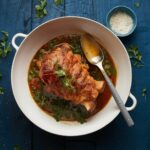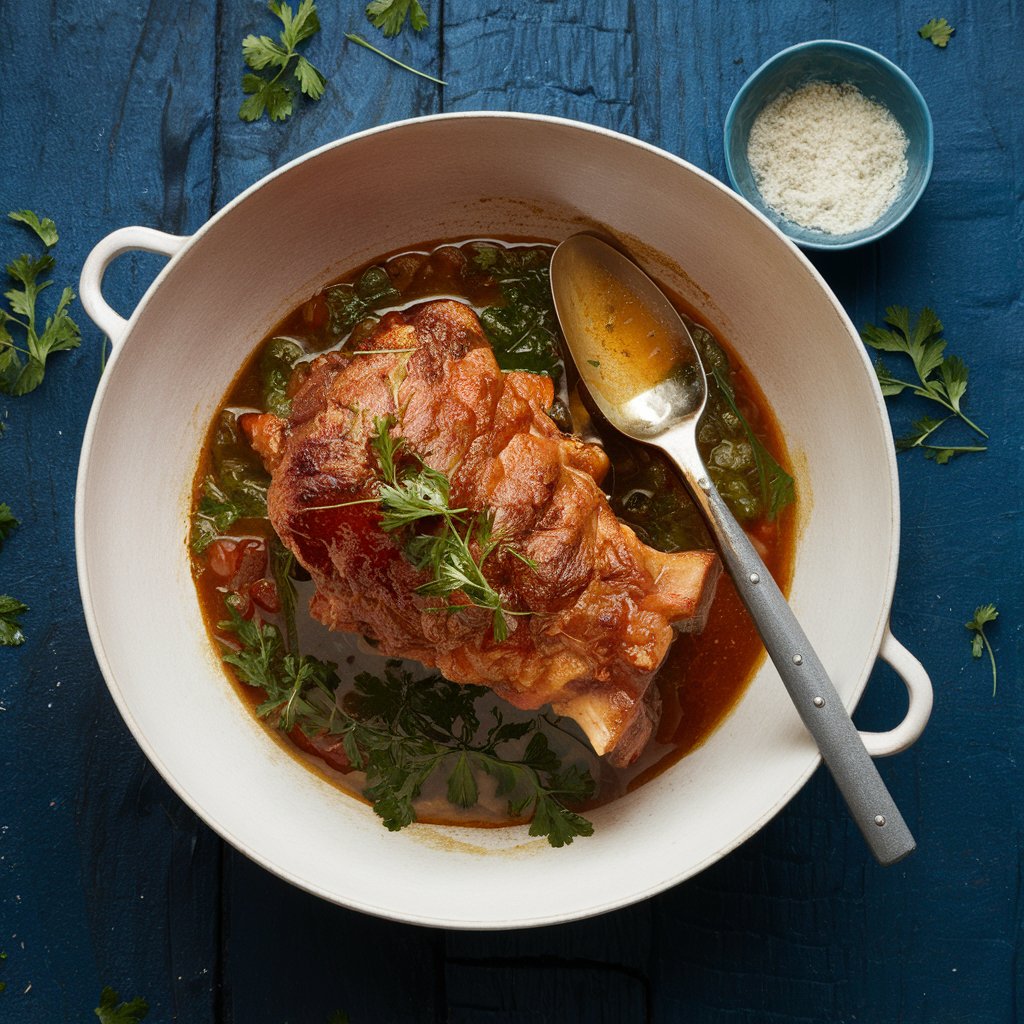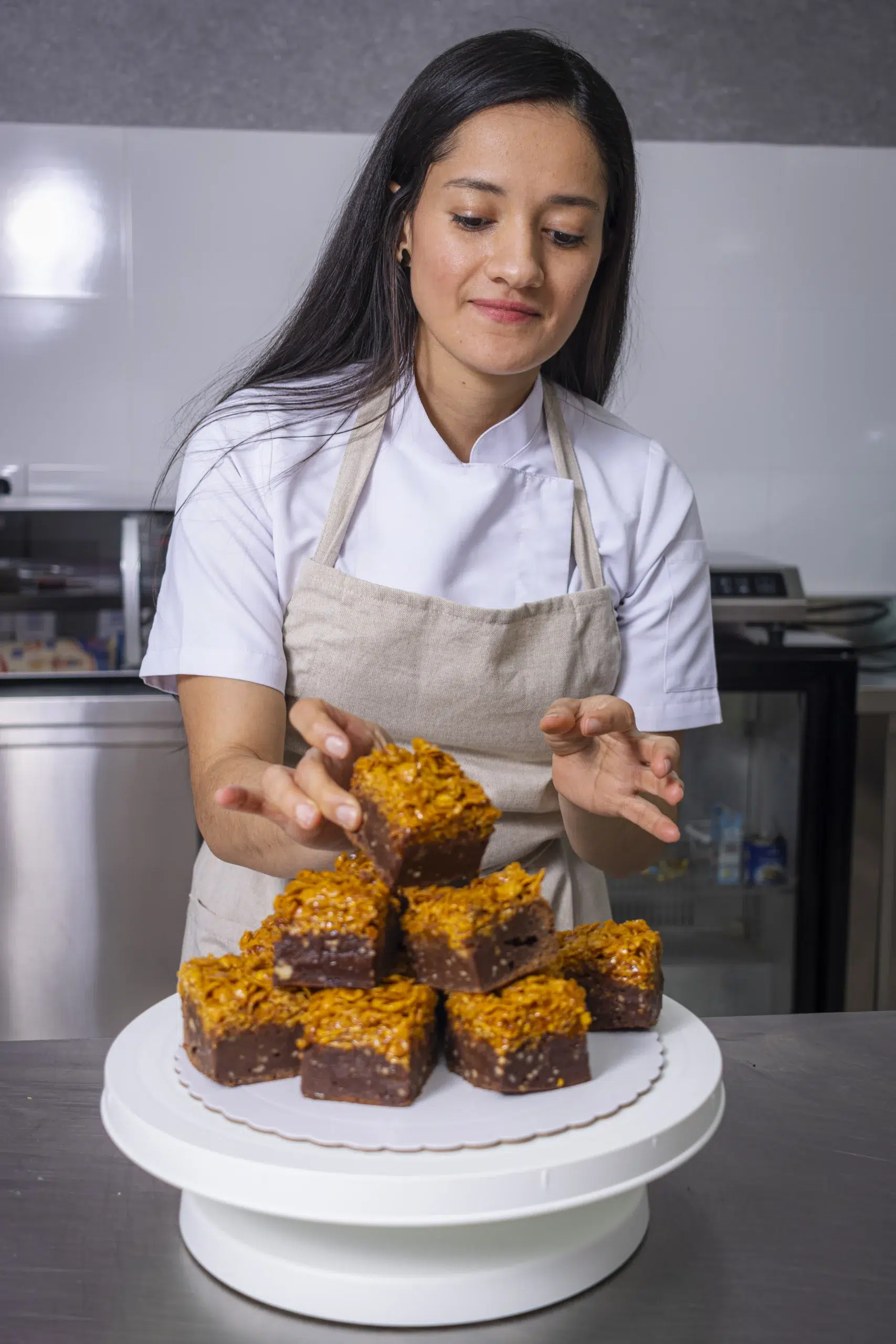Introduction to Shanks
What Are Shanks?
Shanks come from the lower leg of an animal, usually beef or lamb. Known for their tough fibers and marrow-filled bones, they add a deep, savory flavor to dishes. This cut is typically inexpensive but requires long, slow cooking to break down the connective tissue and .make the meat tender. Shank cooking methods often involve moist heat to achieve the best results.
Looking for more ideas? Check out our beef shank recipe for a delicious slow-cooked meal.
Why Cooking Methods Matter
Cooking methods play a crucial role in the texture and flavor of shanks. Because shanks are tough, they need to be cooked slowly and at a low temperature to become tender. The right method can turn a tough piece of meat into a succulent, fall-off-the-bone delight. In this article, we’ll explore the most effective ways to cook shanks, ensuring you get the best results every time.
Popular Cooking Methods for Shanks
There are several methods commonly used to cook shanks, each with its advantages. Here, we’ll delve into the details of each technique:
- Slow Cooking: Ideal for hands-off cooking and results in incredibly tender meat.
- Braising: Combines dry and moist heat for deep, rich flavors.
- Roasting: Uses dry heat to create a crispy exterior and juicy interior.
- Boiling and Simmering: Simple methods that can yield tender meat.
- Smoking: Adds a unique smoky flavor and tenderizes the meat over low heat.
Let’s start with the first method:
Slow Cooking
Slow cooking works wonders for shanks. This method involves cooking the meat at a low temperature for an extended period, allowing the tough fibers to break down and the flavors to meld together. Here’s how to do it:
- Preparation: Season the shanks with salt, pepper, and any other desired spices. You can also marinate them for redundant flavor.
- Searing: Sear the shanks in a hot pan with a bit of oil until they are browned on all sides. This step, although optional, adds depth to the flavor.
- Cooking: Place the shanks in a slow cooker with your choice of vegetables (like onions, carrots, and celery) and liquids (such as broth or water). Cook on low for 6-8 hours until the meat is tender and falling off the bone.
- Finishing: Once cooked, thicken the cooking liquid into a gravy or serve the shanks with the juices as they are.
Slow cooking is perfect for those who want a hassle-free method that requires minimal attention. The result is tender, flavorful meat that pairs well with a variety of sides, such as mashed potatoes or rice.
Don’t miss our guide on how long does beef shank take to get tender for perfect timing.
For tips on achieving the best results with slow cooking, visit Best Temperature to Cook Meatloaf: Optimal Times & Tips.
Braising: A Perfect Method for Shanks
Braising combines both dry and moist heat to cook shanks, making it an excellent method for achieving deep, rich flavors and tender meat. This technique involves first searing the meat at a high temperature and then slowly cooking it in a covered pot with liquid. Let’s break down the process:
How to Braise Shanks
- Preparation: Start by seasoning the shanks with salt, pepper, and other preferred spices.
- Searing: Heat a small amount of oil in a heavy-bottomed pot or Dutch oven. Sear the shanks on all sides until they develop a golden-brown crust. This step enhances the flavor.
- Deglazing: After searing, remove the shanks and add a bit of liquid (like broth or water) to the pot to deglaze it. Scrape up the browned bits from the bottom of the pot; these add a lot of flavors.
- Cooking: Return the shanks to the pot. Add enough liquid to come about half up the sides of the meat.
Include vegetables such as onions, carrots, and celery for added flavor. Cover the pot and cook at a low simmer or in a preheated oven (around 325°F or 160°C) for 2-3 hours, or until the meat is tender. - Finishing: Once the shanks are tender, remove them from the pot. You can reduce the cooking liquid to make a sauce or gravy to serve with the meat.
Benefits of Braising
Braising allows the tough fibers in shanks to break down gradually, resulting in succulent, tender meat that is full of flavor. The combination of dry and moist heat ensures that the meat stays juicy while developing a rich, deep taste.
Discover great ideas like which cooking method is best for a chuck roast if you love tender meats. For a comprehensive guide on braising techniques, check out Which Cooking Method is Best for a Chuck Roast?.
Tips for Braising
- Use a heavy- bottomed pot or Dutch roaster to insure indeed cooking.
- Don’t rush the cooking process; low and slow is key to tender shanks.
- Experiment with different liquids such as beef broth, vegetable broth, or even tomato sauce to vary the flavor profile.

Roasting: Achieving a Crispy Exterior and Juicy Interior
Roasting shanks involves cooking them in an oven at high temperatures, which creates a crispy exterior while keeping the interior juicy and flavorful. This method is excellent for those who enjoy a bit of texture in their meat.
How to Roast Shanks
- Preparation: Preheat your oven to 350°F (175°C). Season the shanks with salt, pepper, and any preferred herbs or spices.
- Searing: Sear the shanks on all sides in a hot pan until they are golden brown. This step cinches in the authorities and enhances the flavor.
- Roasting: Place the seared shanks on a roasting pan or baking sheet. Surround the meat with vegetables like carrots, potatoes, and onions for a complete meal. Roast in the preheated oven for about 2-3 hours, or until the shanks are tender. Occasionally baste the shanks with their juices to keep them moist.
- Finishing: Allow the shanks to rest for about 10 minutes after roasting. This lets the juices redistribute throughout the meat, ensuring a juicy bite.
Benefits of Roasting
Roasting shanks is a straightforward method that requires minimal preparation and attention. It’s perfect for those who want a crispy, flavorful crust on their meat. Additionally, roasting allows you to cook vegetables simultaneously, making it a convenient one-pan meal. For more roasting tips and recipes, visit How Long to Cook Meatloaf at 375.
Tips for Roasting
-
- Use a meat thermometer to ensure the shanks reach an internal temperature of 160°F (70°C) for safe consumption.
- For added flavor, consider marinating the shanks overnight before roasting.
- If the shanks start to brown too quickly, cover them loosely with aluminum foil to prevent burning.
Boiling and Simmering: Simple Methods for Tender Shanks
Boiling and simmering are straightforward methods that can yield tender, flavorful shanks. These techniques involve cooking the meat in liquid over low heat for an extended period, allowing the tough fibers to break down gradually.
How to Boil and Simmer Shanks
- Preparation: Begin by seasoning the shanks with salt, pepper, and your preferred spices.
- Boiling: Place the shanks in a large pot and add enough water or broth to cover them. Bring the liquid to a pustule over high heat.
- Simmering:
- Finishing: After cooking, remove the shanks from the pot and let them rest for a few minutes before serving. The cooking liquid can be used as a broth or reduced to make a sauce.
Benefits of Boiling and Simmering
Boiling and simmering are ideal for those who want a simple, hands-off method to cook shanks. These techniques ensure that the meat becomes incredibly tender and absorbs the flavors of the cooking liquid. Moreover, the broth created can be used in soups or stews, adding an extra layer of flavor to other dishes. For more on how long it takes for beef shanks to get tender, check out How Long Does Beef Shank Take to Get Tender?.
Tips for Boiling and Simmering
- Skim any foam that forms on the surface of the liquid during boiling to keep the broth clear.
- Using a mix of water and broth will provide a richer flavor.
- Adding herbs like thyme, bay leaves, and garlic can enhance the taste of the shanks and broth.
Smoking: Adding a Unique Smoky Flavor to Shanks
Smoking is a method that uses low heat and smoke to cook shanks, infusing them with a rich, smoky flavor. This technique requires patience and the right equipment, but the results are well worth the effort.
How to Smoke Shanks
- Preparation: Start by seasoning the shanks with a dry rub of your choice. Common ingredients include salt, pepper, paprika, garlic powder, and brown sugar.
- Setting Up the Smoker: Preheat your smoker to 225°F (107°C). Use wood chips like hickory, oak, or applewood for the best flavor.
- Smoking: Place the shanks in the smoker, ensuring they are not overcrowded. Smoke the shanks for about 4-6 hours, or until the internal temperature reaches 190°F (88°C). This ensures the meat is tender and full of smoky flavor.
- Finishing: After smoking, let the shanks rest for at least 15 minutes before serving. This allows the authorities to redistribute, making the meat more succulent.
Benefits of Smoking
Smoking shanks imparts a unique flavor that cannot be achieved with other cooking methods. The low and slow process not only tenderizes the meat but also enhances its taste with a deep, smoky aroma. Moreover, smoking adds a beautiful bark or crust to the exterior of the shanks, providing a delightful texture contrast.
Tips for Smoking
- Maintain a consistent temperature in the smoker to ensure even cooking.
- Trial with different wood chips to find your preferred flavor profile.
- Use a meat thermometer to monitor the internal temperature of the shanks accurately.
Comparing Cooking Methods for Shanks
Comparison of Cooking Methods: Which is Best for Shanks?
Choosing the right cooking method for shanks can make a significant difference in texture and flavor. In this section, we’ll compare slow cooking, braising, roasting, boiling, simmering, and smoking to help you decide which method suits your needs best.
Tenderness and Flavor
- Slow Cooking: Produces extremely tender meat that falls off the bone. The long cuisine time allows flavors to immingle beautifully.
- Braising: Combines dry and moist heat for deep, rich flavors and tender meat. It’s perfect for creating a hearty dish with complex flavors.
- Roasting: Gives the meat a crispy exterior while keeping the inside juicy. It’s great for those who enjoy a bit of texture in their meat.
- Boiling and Simmering: These methods make the meat very tender and infuse it with the flavors of the cooking liquid. They are simple and effective.
- Smoking: Imparts a unique smoky flavor and creates a delicious crust on the meat. It’s ideal for those who love smoky, barbecued flavors.
Ease of Cooking
- Slow Cooking: Very easy and hands-off. Simply set it and forget it.
- Braising: Requires some initial preparation but is mostly hands-off once it’s simmering.
- Roasting: Fairly straightforward, but requires occasional basting.
- Boiling and Simmering: It’s a simple and uncomplicated system.Just keep a watchful eye on the pot.
- Smoking: Requires more attention and specialized equipment, but the results are worth it.
Versatility
- Slow Cooking: Versatile and can be used for a variety of dishes.
- Braising: Ideal for rich, hearty meals.
- Roasting: Great for one-pan meals with vegetables.
- Boiling and Simmering: Perfect for soups and stews.
- Smoking: Best for adding a distinctive flavor to meat.
Expert Tips for Perfect Shanks
- Season Well: Always season your shanks generously to enhance the flavor.
- Use Quality Ingredients: Fresh herbs, good quality broth, and fresh vegetables can make a big difference.
- Don’t Rush: Shanks need time to become tender. Be patient and cook them low and slow.
- Rest the Meat : Let the cutters rest once they are done cuisine. This allows the authorities to redistribute, performing in juicier meat.

Frequently Asked Questions about Cooking Shanks
Cooking shanks can raise many questions, especially for those new to this cut of meat. Here, we’ll address some frequently asked questions to help you master cooking shanks.
What is the Best Cooking Method for Beef Shanks?
The best method for cooking beef shanks largely depends on your taste preferences and the equipment you have. Generally, slow cooking and braising are highly recommended as they make the tough meat incredibly tender and flavorful. However, roasting can also yield excellent results if you prefer a crispy exterior.
How Long Should You Cook Lamb Shanks?
Lamb shanks typically need to be cooked for about 2-3 hours when braising or roasting. If you’re slow cooking, plan for 6-8 hours on low heat. The key is to cook them until the meat is tender and falls off the bone.
Can You Roast Shanks in the Oven?
Absolutely! Roasting shanks in the oven is a great method to achieve a crispy exterior while keeping the inside juicy. Preheat your oven to 350°F (175°C), and roast the shanks for 2-3 hours, basting occasionally to keep them moist.
What Liquids are Best for Braising Shanks?
For braising, you can use a variety of liquids to add flavor. Beef broth or vegetable broth are classic choices. You can also use tomato sauce or a mix of broth and water. Adding aromatic vegetables like onions, carrots, and celery enhances the flavor profile.
Looking for inspiration? Try our beef shank recipes collection for new ideas.
Don’t miss our similar guide on cooking methods for shanks.
Final Thoughts on Cooking Shanks
Mastering the art of cooking shanks can transform a tough, inexpensive cut of meat into a gourmet meal. Whether you prefer the hands-off convenience of slow cooking, the rich flavors of Braising, the crispy texture from roasting, the simplicity of boiling and simmering, or the distinctive taste from smoking, there’s a method for everyone. Experiment with different techniques and find the one that works best for your palate and lifestyle.
Print
Which cooking method is best for the shanks?
- Total Time: 3 hours 15 minutes
- Yield: 4 servings 1x
Description
Discover the best cooking method for beef shanks to achieve tender, flavorful meat every time. Learn why braising and slow cooking work best and get tips for perfect results.
Ingredients
- 2–3 lbs beef shanks
- 4 cups beef stock
- 2 tbsp olive oil
- 1 large onion (chopped)
- 2 carrots (diced)
- 2 celery stalks (diced)
- 3 cloves garlic (minced)
- 2 bay leaves
- 1 sprig rosemary
- Salt and pepper to taste
Instructions
- Prep the Shanks: Pat beef shanks dry with paper towels. Season generously with salt and pepper.
- Sear the Meat: In a large Dutch oven, heat olive oil over medium-high heat. Brown shanks on both sides for 3–4 minutes each. Remove and set aside.
- Sauté Vegetables: In the same pot, add onions, carrots, celery, and garlic. Cook for 5 minutes until softened.
- Deglaze and Add Liquid: Pour in beef stock, scraping up browned bits from the bottom. Add bay leaves and rosemary.
- Braise: Return shanks to the pot. Cover and transfer to a 325°F oven for 2.5–3 hours, or until meat is fork-tender.
- Serve: Remove bay leaves and herbs. Serve hot with mashed potatoes or crusty bread.
Notes
- You can also slow cook the shanks on low for 8 hours instead of oven braising.
- For richer flavor, add a splash of red wine during deglazing.
- Prep Time: 15 minutes
- Cook Time: 3 hours
- Category: Main Dish
- Method: Braising / Slow Cooking
- Cuisine: American, European
Nutrition
- Serving Size: 1 portion
- Calories: ~420 kcal
- Sugar: 4g
- Sodium: 880mg
- Fat: 18g
- Saturated Fat: 7g
- Unsaturated Fat: 9g
- Trans Fat: 0g
- Carbohydrates: 10g
- Fiber: 2g
- Protein: 52g
- Cholesterol: 120mg










